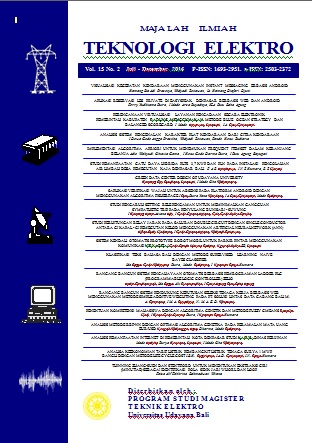Thinning Zhang-Suen dan Stentiford untuk Menentukan Ekstraksi Ciri (Minutiae) Sebagai Identifikasi Pola Sidik Jari
Abstract
Fingerprint is the skin on the palms of the hands and feet that are covered with small ridge lines. Fingerprint pattern belonging to every human is being unique. There are fingerprint on the ridge pattern will not change during human life. Ridge pattern is characteristic of the fingrprint that can be used for biometric identification. Based on fingerprint ridge pattern into four, namely whorl, ulnar loop, radial loop, and arch. Minutiae Extraction (Crossing Number), Core and Delta, Center Point Location can be used for fingerprint pattern recognition. Some of the methods used in the fingerprint pattern recognition is Minutiae Extraction, and Thinning Zhang-Suen and Stentiford. Croosing Number is used for process Minutiae Extraction, example termination and bifurcation. The classification method used Linear Discriminant Analysis. The result fingerprint pattern recognition is system can recognize fingerprint patter as much as 20 images and system can not recognize fingerprint pattern as much as 10 images. Accuracy of fingerprint pattern recognition is 66%.Downloads
References
[2] K. Lakshmi Kumari, P.V.S. Vijaya Babu, and S.V. Kumar, “Dermatoglyphics and Its Relation to Intelligence Levels of Young Students”, IOSR Journal of Dental and Medical Sciences, vol 13, Issues 5 Ver. II, PP 01-03, 2014.
[3] Davit Kocharyan, “A modified fingerprint image thinning algorithm”, American Journal of Software Engineering and Applications, vol. 2 No. 1, pp. 1-6. doi: 10.11648/j.ajsea.20130201.11, 2013.
[4] Patmasari Raditiana, Mohamad Ramdhani, dan Achmad Rizal, “Perancangan perangkat lunak rumus sidik jari pada bentuk sidik jari jenis whorl”, Seminar Nasional Aplikasi Teknologi Informasi, Yogyakarta: 2009”.
[5] Hanung Tysa Saksono, Achmad Rizal, dan Koredianto Usman, ”Pendeteksian kanker paru-paru dengan menggunakan transformasi wavelet dan metode linear dicsriminant analysis”, Teknologi Elektro, Vol. 9, No. 1, Januari-Juni, 2010.
[6] Suheir M. Elbayoumi Harb, Nor Ashidi Mat Isa, and Samy A. Salamah, “Improved image magnification algorithm based on otsu thresholding”, ElSEVIER Computers and Electrical Engineering, 2015.
[7] I. K. G. Darma Putra, “Binerisasi citra tangan dengan metode otsu”, Teknologi Elektro, Vol. 3, No. 2, Juli-Desember, 2004.
[8] T. Y. Zhang and C. Y. Suen, “A fast parallel algorithm for thinning digital patterns”, Communications of the ACM, Vol. 27, No. 3, March 1984.
[9] J.R. Parker, Algorithms for Image Processing and Computer Visions Second Edition, Indianapolis: Wiley Publishing, 2011.
[10] Davide Maltoni, Dario Maio, Anil K. Jain, and Salil Prabhakar, Handbook of Fingerprint Recognition Second Edition. London: Springer, 2009.
[11] Roli Bansal, Priti Sehgal, and Punam Bedi, “A modified thinnning algorithm for minutiae feature exctraction of fingeprint images on FPGA”, International Journal of Computer Science Issues, vol. 8, Issue 5, No 3, September. 2011.
[12] Mingbo Zhao, Zhao Zhang, Tommy W.S. Chow, and Bing Li, “Soft label based linear discriminant analysis for image recognition and retrieval”, ELSIVIER Computer Vision and Image Understanding 121, 88-99, 2014.
[13] Alessandra Biancolillo, Ingrid Mage, and Tormod Naes, “Combining SO-PLS and discriminant analysis for multi-block classification”, ELSEVIER Chemometrics and Intelligent Laboratory Systems 141, 2014.
[14] S. Balakrishnama and A. Ganapathiraju, A Linear Discriminannt Analysis-A Brief Tutorial, Institute for Signal and Information Processing, Mississipi, 1998.
Keywords

This work is licensed under a Creative Commons Attribution 4.0 International License





